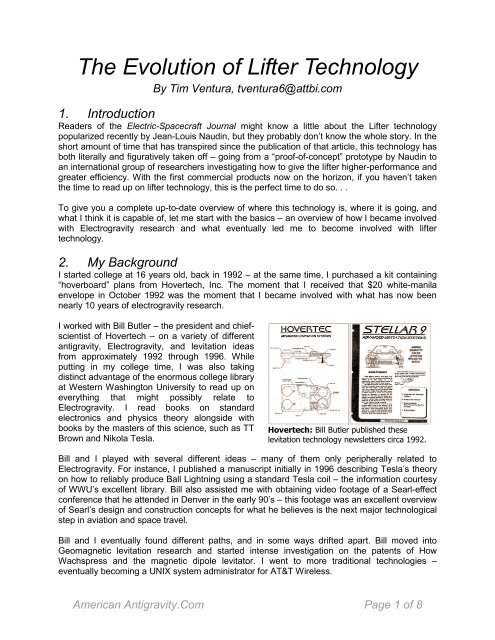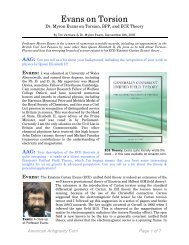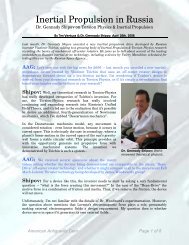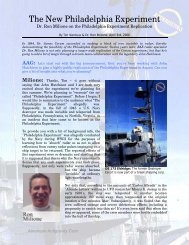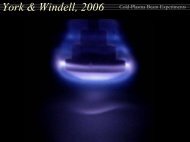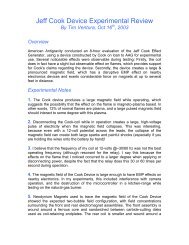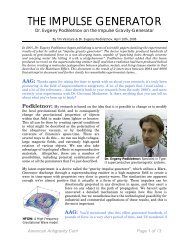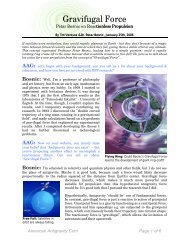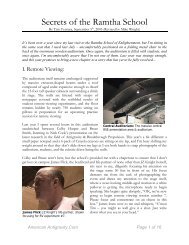The Evolution of Lifter Technology - American Antigravity
The Evolution of Lifter Technology - American Antigravity
The Evolution of Lifter Technology - American Antigravity
You also want an ePaper? Increase the reach of your titles
YUMPU automatically turns print PDFs into web optimized ePapers that Google loves.
<strong>The</strong> <strong>Evolution</strong> <strong>of</strong> <strong>Lifter</strong> <strong>Technology</strong><br />
By Tim Ventura, tventura6@attbi.com<br />
1. Introduction<br />
Readers <strong>of</strong> the Electric-Spacecraft Journal might know a little about the <strong>Lifter</strong> technology<br />
popularized recently by Jean-Louis Naudin, but they probably don’t know the whole story. In the<br />
short amount <strong>of</strong> time that has transpired since the publication <strong>of</strong> that article, this technology has<br />
both literally and figuratively taken <strong>of</strong>f – going from a “pro<strong>of</strong>-<strong>of</strong>-concept” prototype by Naudin to<br />
an international group <strong>of</strong> researchers investigating how to give the lifter higher-performance and<br />
greater efficiency. With the first commercial products now on the horizon, if you haven’t taken<br />
the time to read up on lifter technology, this is the perfect time to do so. . .<br />
To give you a complete up-to-date overview <strong>of</strong> where this technology is, where it is going, and<br />
what I think it is capable <strong>of</strong>, let me start with the basics – an overview <strong>of</strong> how I became involved<br />
with Electrogravity research and what eventually led me to become involved with lifter<br />
technology.<br />
2. My Background<br />
I started college at 16 years old, back in 1992 – at the same time, I purchased a kit containing<br />
“hoverboard” plans from Hovertech, Inc. <strong>The</strong> moment that I received that $20 white-manila<br />
envelope in October 1992 was the moment that I became involved with what has now been<br />
nearly 10 years <strong>of</strong> electrogravity research.<br />
I worked with Bill Butler – the president and chiefscientist<br />
<strong>of</strong> Hovertech – on a variety <strong>of</strong> different<br />
antigravity, Electrogravity, and levitation ideas<br />
from approximately 1992 through 1996. While<br />
putting in my college time, I was also taking<br />
distinct advantage <strong>of</strong> the enormous college library<br />
at Western Washington University to read up on<br />
everything that might possibly relate to<br />
Electrogravity. I read books on standard<br />
electronics and physics theory alongside with<br />
books by the masters <strong>of</strong> this science, such as TT<br />
Brown and Nikola Tesla.<br />
Hovertech: Bill Butler published these<br />
levitation technology newsletters circa 1992.<br />
Bill and I played with several different ideas – many <strong>of</strong> them only peripherally related to<br />
Electrogravity. For instance, I published a manuscript initially in 1996 describing Tesla’s theory<br />
on how to reliably produce Ball Lightning using a standard Tesla coil – the information courtesy<br />
<strong>of</strong> WWU’s excellent library. Bill also assisted me with obtaining video footage <strong>of</strong> a Searl-effect<br />
conference that he attended in Denver in the early 90’s – this footage was an excellent overview<br />
<strong>of</strong> Searl’s design and construction concepts for what he believes is the next major technological<br />
step in aviation and space travel.<br />
Bill and I eventually found different paths, and in some ways drifted apart. Bill moved into<br />
Geomagnetic levitation research and started intense investigation on the patents <strong>of</strong> How<br />
Wachspress and the magnetic dipole levitator. I went to more traditional technologies –<br />
eventually becoming a UNIX system administrator for AT&T Wireless.<br />
<strong>American</strong> <strong>Antigravity</strong>.Com Page 1 <strong>of</strong> 8
I hadn’t heard from Bill Butler in about 6 months when he sent me a short email containing the<br />
words “hey, check this out” – and a link to Jean-Louis Naudin’s “<strong>Lifter</strong> Experiments” home page.<br />
I visited the site, watched all <strong>of</strong> the video clips, and then watched them again. This was the<br />
technology that I had been waiting for!<br />
3. <strong>Lifter</strong> <strong>Technology</strong><br />
I can say without a doubt that the lifter technology is completely revolutionary, but you might not<br />
realize how pr<strong>of</strong>oundly revolutionary it is until you’ve stopped to think about it for a bit. What is it<br />
about the lifter that makes it so unique, especially when so many inventions claim to produce<br />
more and better electromagnetic thrust? <strong>The</strong> answer is simple – the lifter works repeatedly.<br />
Jean-Louis Naudin started a figurative bonfire<br />
when he decided to replicate a “pro<strong>of</strong>-<strong>of</strong>-concept”<br />
experiment by a small Huntsville, AL aerospace<br />
contracting firm. <strong>The</strong> lifter initially came into being<br />
in the mind <strong>of</strong> Jeff Cameron – the chief scientist<br />
<strong>of</strong> Transdimensional Technologies – in the 1970’s<br />
from experiments conducted with high-power<br />
military and research-grade lasers. A device in<br />
the lasers called a “pre-ionizer” was used to apply<br />
a high-voltage to the lasing-medium to facilitate<br />
better performance. Repeated operation <strong>of</strong> the<br />
pre-ionizer had a common side effect <strong>of</strong> horribly<br />
twisting the wire and foil combination out <strong>of</strong><br />
shape, which required a decent amount <strong>of</strong> work<br />
to repair.<br />
Jeff Cameron realized that the torsional effect on<br />
the pre-ionizer was a side effect <strong>of</strong> some<br />
unknown force acting on the pre-ionizer<br />
apparatus, and he began a long-term<br />
investigation into what was causing the apparatus<br />
to deform. His eventual results indicated that a<br />
BB-Effect Rotor: A rotor for testing the BB-<br />
Effect at Transdimensional Technologies.<br />
force in the foil collector in the pre-ionizer was causing a net-thrust in the entire pre-ionizer<br />
apparatus that was making it twist and move on its mounts within the laser – the lifter came to<br />
him later as a three-dimensional device to demonstrate this force.<br />
Naudin’s genius became readily apparent not through a giant breakthrough in technology, but<br />
rather in a more subtle fashion – he replicated the lifter experiments <strong>of</strong> Transdimensional<br />
Technologies and published videos, articles, and complete construction plans on his website to<br />
allow others to do the same. In a manner similar to the open-source s<strong>of</strong>tware movement,<br />
Naudin had taken an incredible scientific find that might have otherwise been overlooked and<br />
done and incredibly charitable and intelligent thing – he gave it away for others to play with. By<br />
following Naudin’s instructions, inventors all over the globe began to slowly replicate the<br />
Transdimensional Technologies experiments and thereby validate the pro<strong>of</strong> <strong>of</strong> concept that Jeff<br />
Cameron had created to show that his “mystery force” was real after all. Naudin <strong>of</strong> course took<br />
advantage <strong>of</strong> these replications <strong>of</strong> the experiment by showcasing them on his own website –<br />
which in turn lends additional credibility to his research.<br />
As far as technology goes, the lifter demonstrates that science and engineering have more than<br />
their share <strong>of</strong> humorous irony. For the years that I researched Electrogravity and antigravity<br />
claims, all <strong>of</strong> the devices that I had seen required something “magic” to make them work. For<br />
instance, Bob Lazar’s UFO-claims could have been reverse-engineered except that they require<br />
<strong>American</strong> <strong>Antigravity</strong>.Com Page 2 <strong>of</strong> 8
‘element 115’ to make them work – an element chemically related to Bismuth that is theorized to<br />
potentially have electrogravitic properties. I will come back to the possible electro-gravitational<br />
properties <strong>of</strong> Bismuth in a bit, as it turns out that this element may in fact provide some use for<br />
future lifter technology.<br />
<strong>The</strong> Searl-effect disc is an even better example <strong>of</strong> the “magic” usually involved with building a<br />
working Electrogravity device. Searl’s ideas seem valid enough, but although he supposedly<br />
demonstrated several working prototypes in the 1950’s, he is currently pursuing millions <strong>of</strong><br />
dollars in research funding in to replicate those experiments in a modern-day setting.<br />
<strong>The</strong> irony involving lifter technology is that while inventors all over the world have been<br />
searching for the perfect electro-gravitational device for decades, the possible working pro<strong>of</strong> <strong>of</strong><br />
concept for many <strong>of</strong> these theories has been sitting in front <strong>of</strong> us the whole time – the lifter costs<br />
less than $10 in parts to build, and none <strong>of</strong> them are magic – in fact, for my experiments, all <strong>of</strong><br />
them were at stores within 2 blocks <strong>of</strong> my house -- balsa wood from the craft store, aluminum<br />
foil from the supermarket, 30-gauge magnet wire from the local Radio Shack, and an old<br />
computer monitor for the high-voltage power-supply.<br />
4. <strong>Lifter</strong> Physics<br />
Whether or not Jeff Cameron knew it at the time<br />
he constructed his lifter prototype, what he was<br />
actually building was a 3 dimensional<br />
representation <strong>of</strong> a drawing on a patent<br />
application by TT Brown in the 1950’s. In the<br />
patent application, the drawing shows a positively<br />
charged wire suspended over a grounded foil<br />
body which was meant to demonstrate the most<br />
basic Biefeld-Brown effect generator. While<br />
Brown’s drawing is a little different than Jeff’s<br />
design, the resemblance is uncanny enough to<br />
indicate that both <strong>of</strong> these men had the same<br />
basic force in mind.<br />
<strong>Lifter</strong>: This is a single-cell <strong>Lifter</strong> utilizing<br />
Biefeld-Brown Effect propulsion.<br />
TT Brown’s patent indicates that this Biefeld-<br />
Brown effect generator works due to a gradient<br />
electrostatic-field between the wire and the foil – in essence, these two elements compose a<br />
low-efficiency, high-voltage air-gap capacitor in which the difference in geometries between the<br />
two capacitive elements generates a net-directional force from the larger element towards the<br />
smaller element. Jeff Cameron seems to have a practical axiom that goes along with this<br />
scientific philosophy, which is that there must be both a leakage current and a capacitance<br />
between the wire and the foil in order for the lifter to function.<br />
Conventional physics says that two capacitor elements <strong>of</strong> different sizes will not generate a netdirectional<br />
force, so what gives? This is actually the thinking that convinced me to abandon my<br />
research into Biefeld-Brown effect technology in 1996 – physics says it doesn’t work. What the<br />
books say will happen is that since the wire can only maintain a lower-capacitance than the foil,<br />
the overall capacitance between the two elements will be reduced to be equivalent to that on the<br />
smallest element (or plate) in the capacitor. This, <strong>of</strong> course, assumes a 2-element series-wired<br />
capacitor, such as the lifter.<br />
I can give you the conventional physics answer to this small riddle by simply saying that the lifter<br />
uses a manifestation <strong>of</strong> ion-wind. This would state that the electrons crossing the air-gap cause<br />
a breeze that causes thrust – since the breeze would be traveling down from the wire to the foil,<br />
<strong>American</strong> <strong>Antigravity</strong>.Com Page 3 <strong>of</strong> 8
the thrust would be up, as demonstrated in testing. In the ion-wind explanation, the electrons<br />
are emitted from small-diameter <strong>of</strong> the positively charged wire in such great abundance that<br />
they move a significant airflow down to the foil where they are absorbed and transported<br />
electrically back to the HV power-supply’s electrical ground.<br />
Airflow: Ion-Wind is an unwanted side<br />
effect in many Biefeld-Brown devices.<br />
That’s the simple explanation. A more difficult to<br />
visualize explanation <strong>of</strong> a more efficient method<br />
<strong>of</strong> generating conventional ion wind involves a<br />
positively-charged emitter stealing electrons <strong>of</strong>f<br />
nearby air-molecules, which in turn experience a<br />
force propelling them down to collect electrons<br />
from the foil, which is still at the ground potential.<br />
<strong>The</strong> reason that this is more efficient is due to<br />
positively charged ions having less chargemobility<br />
than electrons. Electrons can “hop”<br />
atoms in the air-gap, but positively charged ions<br />
must travel the entire distance. Also, since they<br />
have a greater mass than electrons, they produce<br />
more thrust<br />
Conventional physics would seem to have the theoretical answer to why the lifter causes lift, but<br />
in the experimental setting, which is what we now have an abundance <strong>of</strong> thanks to Jean-Louis<br />
Naudin, the conventional physics explanation doesn’t suffice. Experimentally, there are several<br />
deviations from the ion-wind explanation that seem to invalidate it. For instance, if you<br />
completely contain the lifter in a plastic-enclosure, it will still generate lift – this would not be the<br />
case if a breeze were responsible for lifting the device. How could it be, if the breeze is limited to<br />
the inside <strong>of</strong> an enclosure which itself is levitating?<br />
A more compelling pro<strong>of</strong> that Biefeld-Brown is something other than ion-wind comes from<br />
Purdue University, where the lifter experiment was replicated inside a vacuum-enclosure with<br />
positive results. While ion propulsion can work in space, it usually assumes that there is argon,<br />
krypton, or other noble gas to be used as the propellant – the vacuum enclosure showed that<br />
with no gas available for transport the lifter showed a moderate improvement in performance.<br />
<strong>The</strong> vacuum enclosure tests are definitely<br />
compelling evidence that something else is going<br />
on other than ion-wind – at least compelling<br />
enough for NASA to file patent number 6,317,310<br />
– “Apparatus and Method for Generating Thrust<br />
using a Two Dimensional, Asymmetrical<br />
Capacitor Module”. <strong>The</strong> NASA patent description<br />
– which can be accessed from Naudin’s lifter<br />
website – is as vague is it is compelling in that<br />
NASA is basically requesting a patent on any<br />
technology that generates force using two<br />
geometrically dissimilar capacitive plates.<br />
Disregarding the fact that this patent was issued<br />
nearly 50 years after TT Brown’s patent using<br />
nearly identical descriptions and pictures, and<br />
Vacuum: Residual ionization during a<br />
Transdimensional vacuum-chamber test.<br />
also disregarding the fact that NASA also doesn’t understand why the lifter generates thrust, it<br />
seems apparent the this phenomena is gaining credibility in engineering circles while physicists<br />
seemingly continue to deny that anything is going on.<br />
<strong>American</strong> <strong>Antigravity</strong>.Com Page 4 <strong>of</strong> 8
5. Evolving <strong>Technology</strong><br />
Every good movie always has a sequel, and in technology, if at first a major government agency<br />
‘liberates’ your idea, it may seem that a sequel is in order. In the case <strong>of</strong> the lifter, it would<br />
appear that the NASA patent would cover this technology to at least some degree – at least until<br />
someone overturns this patent under the prior-art rule – which means that the next generation<br />
has to be considerably more advanced to escape having the research and development be<br />
forfeit to the government.<br />
<strong>The</strong> pursuit <strong>of</strong> more advanced versions <strong>of</strong> the lifter technology is currently underway by several<br />
independent inventors, as well as Transdimensional Technologies themselves. Most <strong>of</strong> the<br />
private research by inventors has delved into improving the current lifter design to produce a<br />
greater force output and utilize less power to do so. Because the lifter is so simplistic in design,<br />
many <strong>of</strong> these enhancements have been <strong>of</strong> a very basic nature.<br />
Jean-Louis Naudin was the first independent inventor to do serious work with improving the<br />
technology behind the lifter – and even so, the majority <strong>of</strong> his work has utilized similar materials<br />
in more complex arrangements. Naudin has demonstrated dramatically increased lifting forces<br />
by building a “lifter inside a lifter” for demonstration purposes. Naudin has also done a great<br />
deal <strong>of</strong> work in taking breaking up the concept <strong>of</strong> the single triangular lifter into a parallel series<br />
<strong>of</strong> lifting cells – which means that these cells, working in parallel, can contributed to greater<br />
stability and higher force output than any single lifting element.<br />
Saviour – an independent inventor working with<br />
Jean-Louis Naudin – has done some <strong>of</strong> the most<br />
interesting improvements on lifter design since<br />
those by Naudin himself. Saviour’s concerns<br />
have not focused around the “bigger is better”<br />
philosophy that many inventors have stuck by –<br />
he has done several experiments to determine<br />
the radiation output, remote-controlled<br />
applications development, and materials analysis<br />
and improvement on the lifter that others have<br />
not had the time or expertise to conduct.<br />
EM-Field: This shows capacitive polarization<br />
while atmospheric charge-transfer occurs.<br />
A recent experiment by Saviour demonstrates just how this gentleman’s foresight is helping<br />
other experimenters – Saviour substituted nichrome heating wire for the common lightweight<br />
wire used for the emitter, and demonstrated that the lifting force greatly increased when a higher<br />
potential 12-volt charge was used to heat the emitter wire in conjunction with the standard highvoltage<br />
charge coming <strong>of</strong>f it.<br />
Transdimensional Technologies – the developers <strong>of</strong> the initial lifter design – are taking the<br />
approach to optimizing lifter performance to another level. <strong>The</strong>y are currently not-so-secretly<br />
working on a 2 nd generation lifter, which will consist <strong>of</strong> a 1-piece layered material to replace the<br />
current wire and foil design.<br />
<strong>The</strong> layered material approach to the lifter is an idea that Jeff Cameron may or may not have<br />
had after some lengthy discussions with Travis Taylor – the man responsible for testing some<br />
anomalous materials known as “Art’s Parts”.<br />
Art’s Parts were some pieces <strong>of</strong> material sent by an unknown person to the Art Bell radio talkshow<br />
with a note stating that the they were pieces <strong>of</strong> UFO wreckage taken from the <strong>of</strong>ten-cited<br />
“Roswell crash” in 1947. Whether or not the pieces <strong>of</strong> material actually came from that crash is<br />
<strong>American</strong> <strong>Antigravity</strong>.Com Page 5 <strong>of</strong> 8
unknown, but Art Bell did the honorable thing by sending them to an acquaintance in US Army<br />
research named Travis Taylor for a pr<strong>of</strong>essional scientific investigation.<br />
Taylor, who apparently tested the materials after-hours in a world-class research lab to avoid<br />
potential classification by his superiors, used an electron microscope to determine that the<br />
layered materials were actually pieces <strong>of</strong> metal – containing several hundred microscopically<br />
thin layers <strong>of</strong> magnesium and bismuth. Taylor also tested the layered-metal with a high-voltage<br />
apparatus, which seemed to indicate that when a voltage was applied to the material, the<br />
layered metal would move – and in some cases levitate.<br />
Taylor reported his findings to Art Bell and sent video clips <strong>of</strong> his high-voltage experiments,<br />
which eventually made it back to a permanent home on the Art Bell radio show website. In<br />
addition, Taylor conveyed his belief that the only manner in which the pieces <strong>of</strong> metal could<br />
properly be produced was through an advanced form <strong>of</strong> electron-deposition technology, due<br />
(apparently) to an absence <strong>of</strong> oxygen-molecules between the different layers <strong>of</strong> metals.<br />
Additionally, the layers <strong>of</strong> metal were too thin to have been mechanically produced.<br />
Jeff Cameron indicated that Transdimensional Technologies maintained some contact at one<br />
point in time with Travis Taylor, apparently as pr<strong>of</strong>essional colleagues in the defense community<br />
in Huntsville, AL. I am not an expert on this relationship, other than to say that to the best <strong>of</strong> my<br />
knowledge these two individuals knew and contacted each other, and that this is how Jeff<br />
Cameron might have come up with the 2 nd generation lifter idea.<br />
6. Advanced <strong>Lifter</strong> <strong>Technology</strong><br />
As an inventor, I couldn’t care less whether or not the idea for the technology came from a<br />
crashed UFO. To be perfectly honest, I’m not what you would call a “believer” anyways,<br />
although I have <strong>of</strong>ten wondered about it. My point is not to attempt to lend any credibility to<br />
“Art’s Parts”, but rather to tie in the properties <strong>of</strong> the anomalous material’s high-voltage<br />
movement with the underlying theory <strong>of</strong> lifter operation.<br />
Even mentioning a UFO in a respected<br />
publication or article is the kiss <strong>of</strong> death in today’s<br />
world – and I wouldn’t do it if it weren’t an<br />
intricate part <strong>of</strong> the story. <strong>The</strong> other interesting<br />
thought is that the layered material is once again<br />
partially composed <strong>of</strong> Bismuth – which is thought<br />
to possibly have some <strong>of</strong> the same electrogravitational<br />
properties as Bob Lazar’s Area 51<br />
“element 115”. Is there a similarity, or merely a<br />
coincidence between a claim that hasn’t gained<br />
credibility and a technology currently under<br />
development?<br />
<strong>The</strong> lifter in its own right is essentially a layered<br />
material. One <strong>of</strong> those layers is the emitter wire,<br />
Prototype: TT Brown holding a 1960’s era<br />
12,000-rpm rotating prototype disk.<br />
which is highly charged with about 30kV worth <strong>of</strong> electrons, another layer is the air-gap, which is<br />
approximately 3 cm in height, and the final layer is an electrically-grounded “skirt” <strong>of</strong> aluminum<br />
foil that surrounds the lifter. It is also reasonable to expect that there are only two possible<br />
forces at work in the lifter – one <strong>of</strong> which being a possible ion-wind effect moving down from the<br />
emitter to the foil, and the other being a possible Biefeld-Brown effect, moving up through the<br />
foil to the emitter.<br />
<strong>American</strong> <strong>Antigravity</strong>.Com Page 6 <strong>of</strong> 8
<strong>The</strong>re are a few shortcomings in the lifter as a design that might be overcome if we could<br />
transition the layered material from one containing an air-gap to one that does not. For instance,<br />
the lifter is currently a rather delicate object, in that having a wire under tension as the emitter<br />
makes construction difficult for future automated assembly. Additionally, because the air-gap<br />
requires struts to support the emitter wire, a trade <strong>of</strong>f involving the weight versus the strength <strong>of</strong><br />
the struts is additionally involved in any current implementation <strong>of</strong> lifter technology.<br />
Some <strong>of</strong> the other changes that would be helpful to implement when transitioning lifter<br />
technology from one type <strong>of</strong> air-gap to another are changes in the materials used to increase<br />
the dielectric capacity. High-K dielectric materials may be used to increase the displacement <strong>of</strong><br />
electrons in the material to enhance charge transport. And since increasing the dielectric<br />
potential <strong>of</strong> the layered materials also increases the breakdown resistance, it means that thinner<br />
materials can be used.<br />
Layered Materials: This electric force<br />
thruster patented by Gravitec’s Hector<br />
Serrano doesn’t require an air-gap.<br />
Designing a lifter without an air gap would<br />
accommodate lower voltage requirements<br />
between the foil and the emitter. <strong>The</strong> voltage<br />
would not have to create the large e-field gradient<br />
to create a leakage current across such a large<br />
void. <strong>The</strong>refore the overall voltage across the<br />
device could be greatly reduced, without much<br />
cost in thrust. A lower operating voltage in turn<br />
means that a lower-output power-supply can be<br />
used for a given amount <strong>of</strong> current, which<br />
increases the overall efficiency.<br />
Transdimensional Technologies recent research<br />
is utilizing the layered materials approach to<br />
eliminate the air-gap and substitute for it high-k<br />
dielectric materials that may allow higher overall<br />
performance. Although they have not yet released details about the exact composition or<br />
thickness <strong>of</strong> the materials that they are working with, they claim to currently have a 10%<br />
reduction in weight using a low-voltage current across the thickness <strong>of</strong> their newest device.<br />
7. Future <strong>Lifter</strong> <strong>Technology</strong><br />
Thanks to the tremendous amount <strong>of</strong> research being done on lifter technology by<br />
Transdimensional Technologies and a loosely affiliated group <strong>of</strong> inventors around the world, the<br />
future <strong>of</strong> lifter technology seems very bright at this point.<br />
Transdimensional hopes to release some breakthrough research to allow replication <strong>of</strong> their<br />
newest 2 nd generation experiments in the very near future, and along with that stands the<br />
massive body <strong>of</strong> research and advancements being done by inventors and researchers such as<br />
Jean-Louis Naudin, Saviour, the <strong>Lifter</strong>s-group, and myself.<br />
My personal goals are to attempt to assist Transdimensional Technologies in popularizing this<br />
technology to increase awareness <strong>of</strong> it and help “spread the word” about what it is and how it<br />
can potentially help the world.<br />
Imagine if instead <strong>of</strong> getting in your car and driving through the usual maze <strong>of</strong> thoroughfares<br />
and side streets you were able to simply type in your destination and have a flying vehicle take<br />
you there automatically. <strong>The</strong> lifter technology <strong>of</strong>fers to potential to transform the current<br />
transportation market by <strong>of</strong>fering point-to-point aerial transport without the need for roads or<br />
freeways.<br />
<strong>American</strong> <strong>Antigravity</strong>.Com Page 7 <strong>of</strong> 8
Additionally, unlike the magnetic-levitation<br />
(“Maglev”) technologies that are currently being<br />
promoted as the future <strong>of</strong> transportation, the lifter<br />
does not require a specially constructed and<br />
exorbitantly expensive track to operate – the<br />
greatly reduces the per-unit cost on the<br />
technology and opens the door for wider adoption<br />
by the general public for transportation solutions.<br />
Other individuals are currently working to see if<br />
lifter technology may <strong>of</strong>fer cost-effective methods<br />
<strong>of</strong> transport into space, which would reduce the<br />
cost greatly and allow a one-piece, reusable<br />
method <strong>of</strong> moving things into orbit.<br />
Advancements: <strong>American</strong> <strong>Antigravity</strong>’s<br />
<strong>Lifter</strong>-4 is one <strong>of</strong> many larger-scale <strong>Lifter</strong>s.<br />
8. <strong>Lifter</strong> Resources<br />
All <strong>of</strong> the research involved with the lifter technology is available to the public on the Internet.<br />
<strong>The</strong> lists <strong>of</strong> resources below are some <strong>of</strong> the better and more common resources to obtain<br />
detailed lifter information.<br />
<strong>American</strong> <strong>Antigravity</strong><br />
http://tventura.hypermart.net<br />
<strong>The</strong> author’s website that includes video clips, complete instructions, and other related lifter<br />
information.<br />
Jean-Louis Naudin’s “<strong>Lifter</strong> Experiments Website”<br />
http://jnaudin.free.fr<br />
A very in-depth website containing video clips, complete instructions,<br />
World-Wide <strong>Lifter</strong> Replications<br />
http://jnaudin.free.fr/html/lftwrld.htm<br />
An overview with photos and video from many <strong>of</strong> the independent inventors who have<br />
replicated the lifter experiments.<br />
Transdimensional Technologies, Inc<br />
http://www.tdimension.com<br />
<strong>The</strong> home page for Transdimensional Technologies, the developers <strong>of</strong> the lifter design.<br />
Blaze Labs (Saviour’s Research Website)<br />
http://bel.150m.com<br />
An excellent site on research into lifter enhancements, radiation testing, sealed devices,<br />
power supplies, and other topics relating to lifter technology.<br />
<strong>Lifter</strong> Builders Group<br />
http://groups.yahoo.com/group/<strong>Lifter</strong>s<br />
An email group for the exchange <strong>of</strong> research findings for those interested in building lifters or<br />
staying current on the state <strong>of</strong> the technology.<br />
<strong>American</strong> <strong>Antigravity</strong>.Com Page 8 <strong>of</strong> 8


